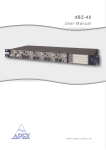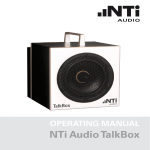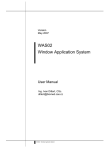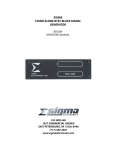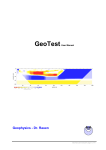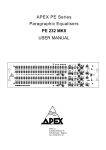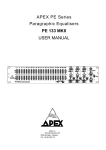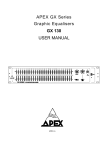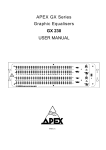Download Apex N.V. Argos User manual
Transcript
ARGOS Sound Level Limiter USER MANUAL VERSION 1.0 - English APEX nv Schoebroekstraat, 62 B-3583 Beringen BELGIUM Tel. +32 11 28 61 91 Fax. +32 11 25 56 38 www.apex-audio.be © Copyright 1999 by APEX n.v. All rights reserved Ordering code for this manual : 90 40 20 0000 10 PRINTING HISTORY DISCLAIMER The information in this document is subject to change without notice. APEX n.v. has made every attempt to ensure that the information in this document is accurate and complete. However APEX n.v. assumes no liability for errors, or for any damage that results from use of this document or the equipment which accompanies it. TRADEMARKS • APEX is a registered trade mark of APEX n.v. • Bussmann is a registered trademark of Bussman Division, Cooper (UK) Limited. • Wickmann is a registered trademark of Wickmann-Werke GmbH All other products or names are trademarks or registered trademarks of their owners. 2 ARGOS - USER MANUAL 2 1 Contents. • General............................................................................................................................2 Printing history, Disclaimer, Trademarks. 1. Contents..........................................................................................................................3 2. Important notes concerning EMC.................................................................................5 EMC, Cautions. 3. Important safety notes...............................................................................................6, 7 Damage requiring service, Servicing, Mains cord, Warning. 4. Installation and precautions .........................................................................................8 Unpack the ARGOS, Installation, Replacing the mains fuse, General care Warmup and condensation, Warning. 5. Definitions and abbreviations of terms........................................................................9 6. Block diagram ..............................................................................................................10 7. Introduction ............................................................................................................11, 12 Applications of the ARGOS, Principle of operation, Connections for the different operation modes. 8. Operation modes..........................................................................................................13 General, The 3 operation modes : Mic, LS, Line. 9. Hold mode.....................................................................................................................14 10. The front panel .............................................................................................................15 11. Description of the front panel .....................................................................................16 12. The rear panel...............................................................................................................17 13. Description of the rear panel ......................................................................................18 14. Installation instructions.........................................................................................19, 20 General connections, Mic, LS, Line. 15. Technical specifications..............................................................................................21 16. Maintenance and service.............................................................................................22 Preventive maintenance. 17. Warranty.......................................................................................................................23 Summary, Items excluded from warranty, Our commitment, Product changes. 18. Your suggestions.........................................................................................................24 • Service request form ...................................................................................................25 • EC declaration of confirmity .......................................................................................26 3 ARGOS - USER MANUAL 3 4 ARGOS - USER MANUAL 4 Important notes concerning EMC. 2 EMC This instrument has been designed to meet the requirements of the EMC Directive 89/336/EEC. Compliance was demonstrated by meeting the test limits of the following standards : Emission : EN50081-1 (1992) Generic emission standard for residential, commercial and light Industry. Test methods and limits used were : • EN 55022 • EN 55022 Conducted, Class B. Radiated, Class B. Immunity : EN50082-1 (1992) Generic emission standard for residential, commercial and light Industry. Test methods and limits used were : • EN 60801-2 • IEC 801-3 • IEC 801-4 (1993) Electrostatic discharge, 8kV air discharge. (1984) RF Field, 3V/m. (1988) Fast transient, 1kV peak (AC line) and 0.5kV peak (signal lines). CAUTIONS To ensure continued compliance with the EMC directive the following precautions should be observed : • For connections to the line-inputs of the ARGOS, use standard coaxial cinch cables. • When it's necessary to extend the microphone cable, use standard coaxial microphone cable. • After opening the case for any reason ensure that the signal and ground connections are put back correctly before replacing the cover. Always ensure all PCB fixing screws and all case screws are refitted correctly and tightened. 5 ARGOS - USER MANUAL 5 3 Important safety notes. The Apex ARGOS was designed and manufactured to meet strict quality and safety standards. There are, however, some installation and operation precautions which you should be particularly aware of : READ AND RETAIN INSTRUCTIONS - All the safety and operating instructions should be read before the appliance is operated and retained for future reference. HEED WARNINGS - All warnings on the appliance and in the operating instructions should be adhered to. FOLLOW INSTRUCTIONS - All operating instructions and instructions for use should be followed. WATER AND MOISTURE - The appliance should not be used near water. For example : near a bathtub, wash bowl, kitchen sink, laundry tub, in a wet basement or near a swimming pool, etc. CARTS AND STANDS - An appliance and cart combination should be moved with care. Quick stops, excessive force, and uneven surfaces may cause the appliance and cart combination to overturn. WALL OR CEILING MOUNTING - When the appliance is mounted to a wall or ceiling, only use for this purpose designed tools. VENTILATION - The appliance should be positioned so that its location or position does not interfere with its proper ventilation. For example, the appliance should not be placed on a bed, sofa, rug, or similar surface which may block the ventilation openings or placed in a built-in situation, such as a bookcase or a cabinet that may impede the flow of air through the ventilation openings. HEAT - The appliance should not be positioned near to heat sources such as radiators, heat registers, stoves, or other appliances (including amplifiers) that produce heat. GROUNDING - Precautions should be taken so that the appliance is properly grounded at all times. POWER CORD PROTECTION - Power supply cords should be routed so that they are not likely to be walked on or pinched by items placed upon or against them. Attention should be payed to cords and plugs particularly at the point where they exit from the appliance. CLEANING - The appliance should be cleaned only as recommended by the manufacturer (see the section : "Maintenance and Service" in this manual). NON-USE PERIODS - The power cord of the appliance should be unplugged from the outlet when left unused for a long period of time. OBJECT AND LIQUID ENTRY - Care should be taken so that objects do not fall and liquids are not spilled into the enclosure through openings. 6 ARGOS - USER MANUAL 6 DAMAGE REQUIRING SERVICE - The appliance must be serviced by an APEX approved service centre when : • Objects have fallen, or liquid has spilled into the appliance. • The appliance has been exposed to rain. • The appliance does not appear to operate normally or shows a noticeable change in performance. • The appliance has been dropped, or the enclosure has been damaged. SERVICING The user should not attempt to service the appliance other than is described in the operating instructions. All other servicing should be referred to qualified service personnel. MAINS CORD • The mains supply of the ARGOS is configured for use in Europe (except the UK) with the mains supply voltage being 220 to 240Vac, 50 / 60Hz and there is no mains voltage selection provided. The appropriate mains supply cord is supplied with the ARGOS. The cord must consist of a minimum 18 AWG and a grounding type attachment plug, rated 15A, 250V. • In case the ARGOS contains a mains supply for use in the UK : 100V/120V, use an UL listed cord set consisting of a minimum 18 AWG, type SVT or SJT three conductor cord, a maximum of 15 feet in length and a parallel blade, grounding type attachment plug, rated 15A, 125V. • In case the ARGOS contains a mains supply for domestic use in the USA : 230, use an UL listed cord set consisting of a minimum 18 AWG, type SVT or SJT three conductor cord, a maximum of 15 feet in length and a tandem blade, grounding type attachment plug, rated 15A, 250V. • The cord set should have the appropriate safety approvals for the country in which the equipment will be installed. • When a 3-core mains lead with bare ends is provided this should be connected as follows : Brown : Blue : Green / yellow : Mains live. Mains neutral. Protective earth. WARNING : • The ARGOS must be grounded. Use power outlets with proper grounding. • Any interruption of the protective conductor inside or outside the ARGOS or disconnection of the protective earth-terminal is likely to cause danger for electric shocks. 7 ARGOS - USER MANUAL 7 4 Installation and precautions. UNPACK THE ARGOS The following should be included with each ARGOS system : 1x 1x 1x 1x ARGOS Microphone Power cord This manual INSTALLATION • The ARGOS may be rack-mounted or free-standing. • The ARGOS will accept voltages from 220 to 240 Vac, 50 / 60 Hz. No voltage regulation setting is necessary. • As with all pieces of precision electronic equipment, follow the next rules when using the ARGOS : - Do not subject the equipment to shocks or vibration. - Avoid extreme temperatures and humidity. - Avoid use in a dusty environment. - Allow adequate ventilation when in operation. REPLACING THE MAINS FUSE • Unplug the mains cord. • Gently lift the lid on the right side of the mains plug. Be cautious, the fuse-holder can not be removed. The first compartment is used for a spare fuse, the second one, nearest to the set, contains the active fuse. • Replace the fuse according the list below : T40mA (slow blow fuse) Wickmann 19195 for 220 / 240 Vac. (Europe) T40mA (slow blow fuse) Bussmann S504 for 220 / 240 Vac. (Europe) • Push back the fuse-holder. GENERAL CARE • Avoid exposing the ARGOS to a dusty or smoke-filled environment. • Clean the surfaces of the ARGOS with a dry, lint- free cloth. Do not use spray cleaners, thinner or solvents. A mild detergent applied to a slightly damp cloth may be used to remove stubborn stains or grease marks. WARMUP AND CONDENSATION If the ARGOS is brought into a warm room from a cold environment, internal condensation may occur. Allow between 1 and 2 hours for the unit to acclimatise before putting it into operation. WARNING : There are no user-serviceable parts inside the ARGOS. Do not disassemble the ARGOS. Refer to an Apex service centre for any repairs or adjustments. 8 ARGOS - USER MANUAL 8 Definitions and abbreviations of terms. 5 dB Logarithmic ratio of voltages, currents or powers. dBm Logarithmic ratio of voltages with reference : 1 mW into 600 Ohm. dBu Logarithmic ratio of voltates with reference : 774,6 mV. dBV Logarithmic ratio of voltages with reference : 1 V. dBASPL Logarithmic ratio of the RMS value of the "A"-weighted sound pressure expressed in Pa and the lowest sound pressure a human ear can detect, being 20 µPa. 1 dBA = 20 * log (P/PRef ) with PRef = 20 µPa. SPL Sound Pressure Level expressed in dB. RMS Root Mean Square. 9 ARGOS - USER MANUAL 9 10 ARGOS - USER MANUAL + - - + + - - + Mu te Microp hone failu re detecto r Mic N orma l / Pin k N oise LS Line VC A "A"- filter R MS detecto r Gain R eduction So und L evel dBA-le vel trimmer LOG converter - + Line Outp ut to Po w er Amplifie r(s) R EF Inte grator N orma l Po w er Amplifier Me asu ring Microp hone Line In put from Prea mplifier or Mixing d esk Pink N oise Generato r Sile nce D ete cto r Mo de Sa mple&H o ld C lip Test ARGOS block diagram 6 Ma nual Au t. Fast 10 7 Introduction. APPLICATIONS OF THE ARGOS The Apex ARGOS is a versatile apparatus which can be applied either as a : • Sound level limiter or • Sound leveler. Applied as a sound level limiter, the ARGOS guarantees that a certain preset maximum level won't be exceeded either to meet legal requirements or just to protect audio-equipment against damage caused by excessive sound levels. Applied as a sound leveler, the ARGOS will take care that f.e. spoken messages throughout background music can be clearly understood. For this application, the internal filter of the ARGOS has to be switched from "A"-weighted to "C"-weighted by replacing jumper J4 which is set to "A"weighted by default. PRINCIPLE OF OPERATION Once installed within an audio chain, the ARGOS makes it impossible to exceed a preset Sound Pressure Level (SPL). The ARGOS doesn’t uncouple the audio signal when the SPL is exceeded but adjusts the signal gradually and continuous in such a way that the maximum is not exceeded. This adjustment occurs in a quasi inaudible way. The dynamics of the signal are unaffected. There is an important difference between a normal limiter and a sound level limiter. A normal limiter is used particularly to prevent distortion of the audio signal if sudden peaks in the signal appear. Each electronic circuit, recording medium or radiotransmitter can only handle a restricted dynamic range. If the input signals exceed a certain value, distortion is the result (overmodulation or clipping). On the other hand, the purpose of a sound level limiter is to limit the sound level produced by a loudspeaker. However, the human ear has not the same sensitivity to all audio frequencies. The human ear is more sensitive to the mid-range (300Hz-3kHz) frequencies and less sensitive to low or high frequencies. This is the reason why most amplifiers have a loudness-switch to compensate for this effect. In the ARGOS, this sensitivity-difference of the human ear is taken into account in the measurement of the sound pressure level. An “A”-weighted filter in the measuring chain passes the mid-frequencies and attenuates the low and high frequencies. This way the measered result correlates with the sound pressure as experienced by the human ear. The ARGOS measures the sound pressure level in exactly the same way as the calibrated sound level meters used by official authorities to check if a sound pressure level meets the legal restrictions. The ARGOS measures the sound pressure level by means of an omni-directional microphone which has a flat frequency range from 20Hz- 20kHz. This signal is amplified and passed through an “A”-weighted filter. The RMS (root mean square) value of this signal is calculated and passed through a logarithmic amplifier . This way a value is obtained which is linearly proportional to the sound pressure expressed in dBA. This value is compared to the preset maximum SPL. If the measured value is lower than the maximum , the audio signal present on the line-input is passed to the output unaltered. However when the measured value is higher than the threshold, the audio signal is attenuated gradually until the measured sound pressure level is the same as the maximum admissible. The dynamics of the audio signal are retained in contrast with a normal limiter that would affect the dynamic contents of the music. Because of the integrating nature of the servo loop, sudden peaks in the sound level of the input-source have no effect on the operation. 11 ARGOS - USER MANUAL 11 The ARGOS is inserted in the audio chain between the source (mixing desk or preamplifier) and the amplifier(s). If one uses an active system (separate amplifiers for different frequency ranges), the output of the ARGOS should be connected to the input of the electronic cross-over. See the figures below on how to connect the ARGOS in the audio chain for the 3 different operation modes : Microphone based operation mode Loudspeaker based operation mode Line based operation mode T O E X T E N S I O N A P E X N .V .B E L G IU M Ar g o s B L E F T A L A NU R CN EB DA L AB N A I G CL H EA T L E F T D N BC A E L D A NU R CN EB DA L A B AN I G C L H AE T ND C E D R To pow e r outlet R L P ow er A m p lifie r L So urce : Mixing d esk, Prea mplifier L R R L OR H igh R L C rossover Mid Low Po w er Amplifiers 12 ARGOS - USER MANUAL 12 8 Operation modes. GENERAL The operation of the ARGOS can be based on three different sources : • Microphone • Line • Loudspeaker signal THE 3 OPERATION MODES Microphone: The best way is to base the operation on the actually measured sound level by means of a microphone placed in the room. The ARGOS measures the sound pressure level in exactly the same way as a sound level (dB) meter used by the authorities. Those parts of the audio chain that are connected at the output of the ARGOS have no effect on the maximum feasible sound level. The position of the volume controls on the amplifier(s), the number of amplifiers and speakers or the efficiency of the loudspeakers don’t have any effect. If the ARGOS is used in microphone-mode, the SLOW response is automatically selected to make sure that sudden crossings of the threshold caused by external noise sources (voices, sounds with an impulsive character) have no effect on the operation. Line: The ARGOS bases its operation on its own output signal (line-outputs). The amplifier(s) and speakers are not part of the servo loop so the gain reduction is not based on a measurement of the sound pressure generated by the speakers as in the microphone operation mode. This Line operation mode is particularly suited in those cases where the maximum allowed SPL is low (<80dBA). If the ARGOS is used to protect an installation from damage or if it is used as a sound leveler, this is also the best solution. If used as a sound level limiter, calibration should take place at maximum volume settings on the amplifier(s), to make sure that after installation no higher sound pressure levels can be reached. Loudspeaker: In these cases where only one amplifier is used and the maximum admissible SPL is low, the operation can be based on the speaker output signal of the amplifier. As such the amplifier becomes part of the servo loop. Therefore the volume settings on the amplifier have no effect on the maximum attainable SPL. FAST/SLOW settings: In the position Line or Speaker the user can choose between fast or slow operation. In these cases where a maximum SPL should not even be exceeded for a short period, one should choose the “FAST” position. However, this setting has the following drawback: if the input signal is too high and the ARGOS has to decrease the level constantly, the operation can become audible. In this situation it is important to adjust the input signal on the mixing desk or preamplifier in such a way that the ARGOS can operate with a minimum of gain reduction. However, if it is important to keep the average sound level below a certain limit, the best choice is the “SLOW” response. This is also the best position if the ARGOS is used as a sound leveler or to protect loudspeakers and amplifiers of getting damaged because of excessive sound levels. 13 ARGOS - USER MANUAL 13 9 HOLD mode Hold Mode By means of the "MODE" pushbutton (7), ARGOS can be put in hold mode. The purpose of the hold-mode is to prevent a decrease in gain reduction when no signal is available at the input coming from the source (mixing desk). This feature reduces unwanted gain changes whenever there is no signal present at the line inputs. There are two methods to operate the hold mode , namely "automatic" and "manual". A sliderswitch (5) behind the cover determines if you are in automatic or manual mode. Automatic Mode When the slider switch behind the cover plate is in "AUTOMATIC" mode, pushing the "MODE" pushbutton (7), you can select between normal operation and automatic hold mode. In automatic mode (the HOLD LED (10) close to the MODE pushbutton is on) the gain reduction is hold at the previous level whenever a silence is detected on the "line" input (signal coming from the mixing desk). Whenever the gain-reduction is hold, LED (15) is lit.The signal at the microphone input has no influence. This mode prevents a change in level whenever a silence between two tracks on a CD is detected or when a pause during a live concert occurs. When starting the next track or whenever the pause is ended, ARGOS continues its operation with the same gain reduction as before. However , ARGOS still prevents the sound level exceeding the threshold. Manual Mode When the slider switch (5) behind the cover plate is in "MANUAL" mode, you can select between "HOLD" and "NORMAL" by pushing the MODE switch (7) on the frontpanel of ARGOS. This is indicated by the two LED's (10 and 11) close to this pushbutton. This feature is usefull if you want to make the decision yourself when ARGOS has to hold the gainreduction. It is only possible to hold the gain reduction if the maximum sound level is not exceeded. The sound level LED bar should indicate that you are below the threshold. If the "MODE" button (7) is pushed, the hold LED (15) close to the gainreduction display is ON, indicating that the gainreduction is hold at the previous level. However, this holding is automatically released, whenever the sound measured sound level exceeds the threshold. You can also release the holding of the gainreduction by pushing the MODE pushbutton again. 14 ARGOS - USER MANUAL 14 10 The front panel 15 ARGOS - USER MANUAL 15 Description of the front panel. (1) dBA-trimmer : To calibrate the ARGOS to the desired or legally imposed maximum sound pressure level during installation of the ARGOS. (2) MODE SELECTION-switch : With this 3-positions-switch the operation mode can be set to : • LINE : (upper position) gain reduction will be based on the level of the Line-output • LS : (middle position) gain reduction will be based on the level of the LS-input. • MIC : (lower position) gain reduction will be based on the level of the Mic-input. The setting of this switch is done during installation. (3) FAST / SLOW-switch : With this 2-position-switch, the reaction speed of the ARGOS can be set during installation. This setting only has effect when the mode selection switch is set to LINE or LS. (4) NORMAL / PINK NOISE-switch : With this 2-positions-switch the ARGOS can be switched from normal operation mode to a mode in which it generates pink noise on the outputs for calibration during installation. MANUAL/AUTOMATIC switch With this 2-positions-switch you can choose between two operation modes for the "hold" mode : "automatic" or "hold" TEST-button : This button is meant for authorities to check wether the ARGOS actually is fitted within the audio chain. When the Test-button is pressed, the output of the ARGOS is muted. MODE-button: By means of this pushbutton Argos can be put in "hold" mode SOUND LEVEL LED-bar : Displays the sound level in comparison with the preset maximum sound level (thresh old). GAIN REDUCTION LED-bar : Displays the gain reduction the ARGOS has to perform on the input signal in order to keep the output signal below the adjusted maximum sound level. HOLD-indicator Indicates that Argos is in 'hold" mode NORMAL-indicator Indicates that Argos is in normal operation mode. The hold function is not in action LINE,LS,MIC indacators Indicates the operation mode selected by means of the MODE SELECTION switch (5) (6) (7) (8) (9) ( 10 ) ( 11 ) ( 12 ) ( 13 ) ( 14 ) ( 15 ) 16 11 CLIP-indicator : Indicates that the ARGOS isn't able to adjust the output level in case : • the ARGOS is not fitted into the audio chain or • the background noise is higher then the threshold. MUTE-indicator: Indicates that the ARGOS is muting the audio-output in case : • the microphone isn't (properly) connected or • a wrong type of microphone is used. HOLD-indicator Indicates that Argos is holding the gain reduction level ARGOS - USER MANUAL 16 12 The rear panel 17 ARGOS - USER MANUAL 17 13 Description of the rear panel. ( 16 ) Mains socket and fuse holder : Connects the plug of the mains lead and houses the primary fuse of the ARGOS. ( 17 ) Extension connector: This connector makes it possible to connect Argos to an optional microprocessor unit ( 18 ) Loudspeaker input : When the mode selection switch is set to LS, the ARGOS will base its limiting operation on the level measured on both loudspeaker-inputs. So if LS-operation is desired, the LS-outputs of the power amplifier should be connected to these inputs. The connection is made by 4 speaker jacks which are grouped in 2 pairs each marked with + / - to indicate the polarity. To which input the left and right channel of the amplifier are connected is of no importance for the operation of the ARGOS. ( 19 ) Microphone input : When the mode selection switch is set to MIC, the ARGOS will base its limiting operation on the level measured on the microphone-input. So if MIC-operation is desired, the microphone should be connected to this input. The connection is made by an XLR-3 connector. ( 20,21,22 ) Line input : When the mode selection switch is set to LINE, the ARGOS will base its limiting opera tion on the level measured on the Line-inputs. So if Line-operation is desired, the Left and Right Line-outputs of the audio-source should be connected to the Left and Right Line-inputs of the ARGOS. Connection is made by 2 cinch-jacks on ( 21 ) A balanced connection by means of XLR-3 connectors is possible by means of ( 20,22 ) ( 23,24,25 ) Line output : This is the general Line-output of the ARGOS which should be connected to the Lineinput of the amplifier(s). Unbalanced connection by means of cinch-cables is possible by means of ( 24 ). A balanced connection by means of XLR-3 cables is possible by means of ( 23,25 ). The balanced outputs are transformer simulating. REMARK: The balanced and unbalanced inputs can be used simultaneously. They are mixed internally.Also the outputs can be used simultaneously. It is advisable to use the balanced connections whenever balanced outputs on the mixing desk or balanced inputs on the amplifier are available. Balanced connections are less sensitive to electromagnetic disturbances. 18 ARGOS - USER MANUAL 18 Installation instructions. 14 GENERAL CONNECTIONS • Connect the LINE- or MASTER-output of the pre-amplifier or the mixing desk to the LINEinput of the ARGOS. • Connect the LINE-output of the ARGOS to the input of the power amplifier or if an active amplification system is used, to the input of the electronic crossover. MIC (MICROPHONE-BASED OPERATION) : When to use ? • When the use of a measuring microphone is desirable. • When the maximum admissible sound level is > 80 dBA. How to calibrate the ARGOS? • Connect the measuring microphone to the MIC XLR-input (15) of the ARGOS. In these cases where the cable is too short , it can be lengthened by means of a normal microphone XLR-cable. The ARGOS will not work properly when another then the included microphone is connected. • Automatically the SLOW operation will be set when the microphone operation mode is selected independant of the position of the FAST / SLOW-switch (3). • Place the microphone on a central location (for instance in the middle above the dance floor). • Slide the mode selection switch (2) to the lowest position so the MIC-indicator (12) is lit. • Adjust the dBA-level trimmer (1) to its maximum by turning it fully clockwise. • Adjust the volume on the amplifier to minimum. • Slide the NORMAL / PINK NOISE switch (4) to the PINK NOISE-position (lowest position). • Use a sound level meter set to “dBA” and “slow or average response” to measure the sound pressure level at an appropriate position in the room. • Adjust the volume on the amplifier to about 10 dBA above the desired or allowed sound level, whichever is lower. • Adjust the dBA-level trimmer (1) slowly until the sound level meter indicates the maximum allowed sound level. Allow the ARGOS to settle on the new gain reduction after adjusting the dBA-level trimmer. The yellow LED’s in the middle of the sound level LED-bar (6) should illuminate and the gain reduction LED-bar should give an indication that the ARGOS is reducing the gain. • Slide the NORMAL / PINK NOISE switch (4) back to NORMAL (upper position). • Mount the frontpanel coverplate and seal it. The ARGOS is ready for use. LS (LOUDSPEAKER-BASED OPERATION) : When to use ? • When only 1 amplifier is used and the maximum admissible sound level is < 80dBA. How to calibrate the ARGOS ? • Connect the loudspeaker outputs of the amplifier to the corresponding Loudspeakerinputs at the rearpanel of the ARGOS. Make sure that the positive outputs of the amplifier (marked “+” or red) are connected to the red inputs (marked "+") on the ARGOS. You don’t have to worry for possible ground loops since the Loudspeaker-inputs on the ARGOS are floating (isolated by transformers in the ARGOS). • The microphone should not be connected. • Slide the mode selection switch (2) to the middle position so the LS-indicator (11) is lit. • Slide the FAST / SLOW-switch (3) to the desired position. This switch should be set to FAST if the level shouldn't even exceed the threshold for a short time. However, the SLOW mode is much more pleasant to listen to because of the smooth operation. 19 ARGOS - USER MANUAL 19 • Adjust the dBA-level trimmer (1) to its maximum by turning it fully clockwise. • Adjust the volume on the amplifier to minimum. • Slide NORMAL / PINK NOISE switch (4) to the PINK NOISE-position (lowest position). • Use a sound level meter set to “dBA” and “slow or average response” to measure the sound pressure level at an appropriate position in the room. • Adjust the volume on the amplifier to about 10 dBA above the desired or allowed sound level. • Adjust the dBA-level trimmer (1) slowly until the sound level meter indicates the maximum allowed sound level. The yellow LED’s in the middle of the sound level LED-bar (6) should illuminate and the gain reduction LED-bar should give an indication that the ARGOS is reducing the gain. • Slide the NORMAL / PINK NOISE switch (4) back to NORMAL (upper position). • Mount the frontpanel coverplate and seal it. The ARGOS is ready for use. LINE (LINE-BASED OPERATION) : When to use ? • When more then 1 amplifier is used and if the maximum admissible sound level is < 80dBA • In these cases where the use of a microphone is not desired. • When the ARGOS is used in mobile installations to protect the speakers from overload. • When the ARGOS is used as a sound leveler. How to calibrate ? • Connect the LINE outputs of the preamplifier or mixing desk or to the corresponding LINEinputs at the rearpanel of the ARGOS. • The microphone should not be connected. • Slide the mode selection switch (2) to the upper position so the LINE-indicator (10) is lit. • Slide the FAST / SLOW-switch (3) to the desired position. This switch should be set to FAST if the level shouldn't even exceed the threshold for a short time. However, the SLOW mode is much more pleasant to listen to because of the smooth operation. • Adjust the “dBA-level” trimmer (1) to its minimum by turning it fully counterclockwise. • Adjust the volume of the amplifier(s) to minimum. • Slide the NORMAL / PINK NOISE-switch (4) to the PINK NOISE position • Adjust the volume of the amplifier(s) to maximum. • Use a sound level meter set to “dBA” and “slow or average response” to measure the sound pressure level at an appropriate position in the room. • Adjust the dBA-level trimmer (1) slowly until the sound level meter indicates the maximum allowed sound level. The yellow LED’s in the middle of the sound level LED-bar (6) should illuminate and the gain reduction LED-bar should give an indication that the ARGOS is reducing the gain. • Slide the NORMAL / PINK NOISE switch (4) back to NORMAL (upper position). • Mount the frontpanel coverplate and seal it. The ARGOS is ready for use. 20 ARGOS - USER MANUAL 20 15 Technical specifications. AUDIO SPECIFICATION. Frequency response ........................................10 Hz - 40 kHz THD + Noise @1kHz, 0dBm input level ................................. <0,1% Input impedance .................................................10 k Ohm Output impedance .................................................100 Ohm Speaker input impedance .................................................20 k Ohm Maximum input - output level balanced inputs-outputs........+24 dBm Noise linear unbalanced 22Hz-22kHz ...............................-95 dBm “A” weighted .................................................-102 dBm Noise linear balanced 22Hz-22kHz ...............................-89 dBm “A” weighted ...................................................-95 dBm “A” filter accuracy Pink noise output level Pink noise flatness Maximum gain reduction Adjustment range Line output level setting MIC dBA setting Speaker 27Hz-20kHz ..............................± 1,2 dB ...................................................-20 dBm 10Hz-30kHz .................................± 1 dB .......................................................60 dB ..................................-46 dBm till +6dBm .........................................60 till 112 dBA ................................12,5 mW till 1800 W ± 0,2 dB typical <= 0,02% typical / 8 Ohm POWER SUPPLY. Voltage Frequency Power consumption Safety requirements ..........................................220 - 240 Vac ................................................50 - 60 Hz .........................................6 W at 230Vac .....................................................IEC 65 CABINET. Dimensions Weight 21 ..................................482 x 44 x 160 mm ......................................................2,5 kg ARGOS - USER MANUAL 21 Maintenance and service. 16 PREVENTIVE MAINTENANCE. • Preventive maintenance consists of cleaning and visual inspection of the ARGOS. When accomplished regularly, preventive maintenance may prevent malfunction and lengthen the apparatus life. The severity of the environment in which the ARGOS is used determines the required frequency of preventive maintenance. Regular cleaning prevents dust from penetrating the apparatus. • The front panel can be cleaned with a soft cloth or a small soft-bristle brush. The brush is particular useful for dislodging dirt on and around the controls. Dirt that remains can be removed with a soft cloth dampened in a mild detergent-and-water solution. Do not use strong solvents as they may damage the paint, the screened lettering or the plastic control knobs. The rear panel can be cleaned in the same way as the front panel. • The top cover minimises accumulation of dust inside the unit and should normally be in place when using the ARGOS. Dirt on components acts as an insulating blanket, preventing efficient heat dissipation. It also provides an electrical conduction path that could result in failure, especially under high-humidity conditions. Normally, internal cleaning of the ARGOS is not necessary when the cover is left in place. 22 ARGOS - USER MANUAL 22 17 Warranty. SUMMARY. We, Apex nv Bosdel 52, 3600 Genk Belgium warrant to you, the original purchaser and any subsequent owner of this Apex product, for a period of one year from the date of purchase by the original purchaser that the product is free of defects in components and factory workmanship under normal use and service. The date of purchase is the date appearing on the first end-user’s bill of sale or other proof of original purchase from an authorised Apex dealer. ITEMS EXCLUDED FROM WARRANTY. We are not responsible for product failure caused by misuse, accident or neglect. This warranty shall not be applicable to any product on which the serial number has been defected, altered or removed. It does not cover damage to other components, connected to the Apex product, resulting from Apex product failure. This warranty shall be considered void if this product is subjected to repair work or alteration by persons other than authorised by Apex in such as manner as to injure, in the sole judgement of Apex, the performance, stability, reliability or safety of this product. The warranty does not apply to finish or appearance items. OUR COMMITMENT. During the warranty period, when failing to perform as specified, Apex will undertake to repair or at its option, replace this product at no charge to its owner, provided the unit is returned, shipping prepaid, to the factory or authorised service facility. You must notify us your need for warranty service, preferably by filling in the request form and returning it to us. We will give you notice of the authorised service centres to whom you may deliver the product or we will give you an authorisation to return it to the factory. All components must be shipped in a factory pack, shipping prepaid. If needed replacement packing can be obtained from us. Corrective action will be taken within reasonable time of the date receipt of the defective product by us or the service centre. If the repairs made by Apex or the authorised service centre are not satisfactory, notify Apex or the service centre immediately. Repairs and replacements parts provided under the terms of this warranty shall carry only the unexpired portion of this warranty. PRODUCT CHANGES. We reserve the right to change the design on any product without prior notice and without the obligation to make corresponding changes in products previously manufactured. If you have any suggestions for the ARGOS, new features, manual, or whatever, please let us know. 23 ARGOS - USER MANUAL 23 18 Your suggestions. If you have any suggestions for the ARGOS, new features, manual, or whatever, please let us know. We would be very happy with your opinion. You can contact Apex through your local dealer, or contact us directly. NOTES. ............................................................................................................................... ............................................................................................................................... ............................................................................................................................... ............................................................................................................................... ............................................................................................................................... ............................................................................................................................... ............................................................................................................................... ............................................................................................................................... ............................................................................................................................... ............................................................................................................................... ............................................................................................................................... ............................................................................................................................... ............................................................................................................................... ............................................................................................................................... ............................................................................................................................... ............................................................................................................................... ............................................................................................................................... ............................................................................................................................... ............................................................................................................................... ............................................................................................................................... ............................................................................................................................... ............................................................................................................................... ............................................................................................................................... ............................................................................................................................... ............................................................................................................................... ............................................................................................................................... ............................................................................................................................... ............................................................................................................................... ............................................................................................................................... ............................................................................................................................... ............................................................................................................................... ............................................................................................................................... ............................................................................................................................... ............................................................................................................................... 24 ARGOS - USER MANUAL 24 APEX ARGOS SERVICE REQUEST FORM Please copy and complete this form as complete as possible and return it to APEX or an authorised APEX service centre together with the defective unit. Name / Company : ........................................................................................................................... Address : ........................................................................................................................... : ........................................................................................................................... Country : ........................................................................................................................... Phone : ........................................................................................................................... Facsimile : ........................................................................................................................... E-mail : ........................................................................................................................... Model number Purchased from Date : ARGOS Serial Number : ................................................................................. : ........................................................................................................................... : ........................................................................................................................... • Describe the symptoms of the malfunction : • Under what condition does the malfunction occur ? At high signal levels Others (please explain) At high temperature. • How often did the problem occur ? • What did you to isolate the problem to this unit ? • Further comments : 25 ARGOS - USER MANUAL 25 APEX ARGOS EC DECLARATION OF CONFIRMITY We, APEX N.V. Schoebroekstraat, 62 B-3583 Beringen BELGIUM declare that the APEX ARGOS meets the intent of the EMC Directive 89/336/EEC and the Low Voltage Directive 73/23/EEC. EMC Compliance was demonstrated by conformance to the following specifications which have been listed in the Official Journal of the European Communities : Emission : EN50081-1 (1992) Generic (Light Industrial) referring to : a) EN 55022 Conducted, Class B b) EN 55022 Radiated , Class B Immunity : EN 50081-1 (1992) Generic (Light Industrial) referring to : a) EN 60801-2 (1993) Electrostatic Discharge b) IEC 801-3 (1984) RF Field c) IEC 801-4 (1988) Fast Transient Safety EN 60950-A3 (1995) E4 Environments ................................................. Paul Van Hees Managing Director. 1 July 1999 26 ARGOS - USER MANUAL 26


























